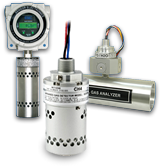Coming SOON!!!!
Since the release of the original SEC Millenium 22 years ago, our engineers have designed and implemented enhanced optical absorption integrity, lower power consumption and developed software algorithms for our other infrared family of gas detectors and analyzers. All of this knowledge, experience and features have been incorporated into the SEC Millenium Hawk.

Gas Detectors Guard Federal Office Building in Rapid City, SDFebruary 2, 2010
 A pair of gas detectors is guarding against physical and fiscal problems in the air-conditioning at the Federal office building in Rapid City, South Dakota. The three-story building houses regional federal facilities including district courtrooms, attorneys, IRS offices, Department of Agriculture personnel, computer rooms and ancillary services. Problem facing service contractor Mike LaForest was possible leaks of R-22 refrigerant in the mechanical –equipment room. The room has two chillers – a 130-ton Trane and a 75-ton York – plus condensers, tanks, pipes, valves, controls. The physical problem is that R-22 is heavier than air, so a leak could swiftly deplete oxygen in the room, meaning sickness, unconsciousness and even possible death for personnel in the area. The fiscal problem is that R-22 is costly – "and getting more costly all the time," groans LaForest. "In fact, R-22 prices have more than doubled in the past year alone." Then too, losing even small quantities of R-22 would mean lower system operating efficiencies, and therefore higher electric bills in scalding South Dakota summers. Solution for LaForest was those two gas detectors – actually oxygen and R-22 detectors – placed in the mechanical equipment room. Manufactured by Minneapolis- based Sensor Electronics, the O2 detector warns the instant oxygen levels drop below 19 per cent. The R-22 detector works the opposite way, howling if refrigerant levels go too high. The O2 detector is linked to its own dedicated transmitter that shows real-time readouts on a digital panel, updated every second. In addition, the transmitter features color coded LED’s that glow green so long as oxygen levels in the equipment room are safe. If O2 readings drop below 19 per cent, the LED’s immediately go amber, then red at the danger point. In addition, the transmitter turns on alarm lights and horns to evacuate personnel. Similarly, the R-22 detector goes into alarm when it spots a leak, then shuts down the chillers. Installation of the O2 detector/transmitter package was straight-forward: A 120-volt line to the transmitter and a low-voltage link to the detector. Cost of the setup was less than $3000. More information: Sensor Electronics, 5500 Lincoln Drive, Minneapolis 55436; 800.285.3651 or sales@sensorelectronics.com. |







